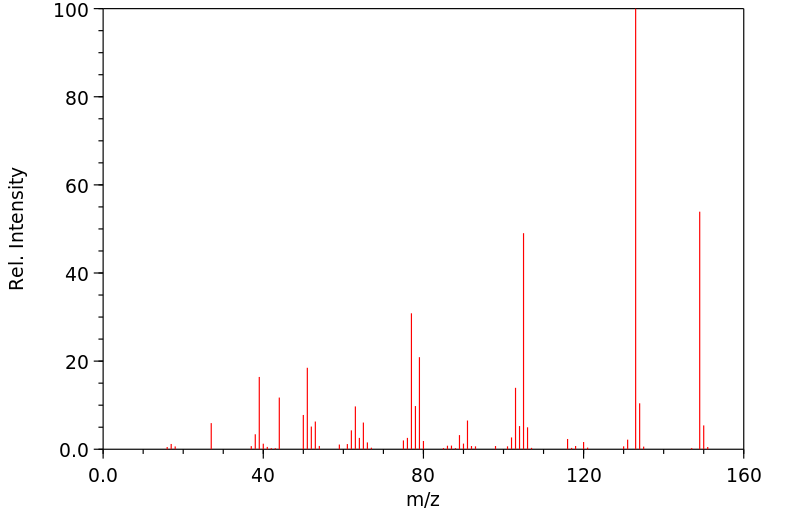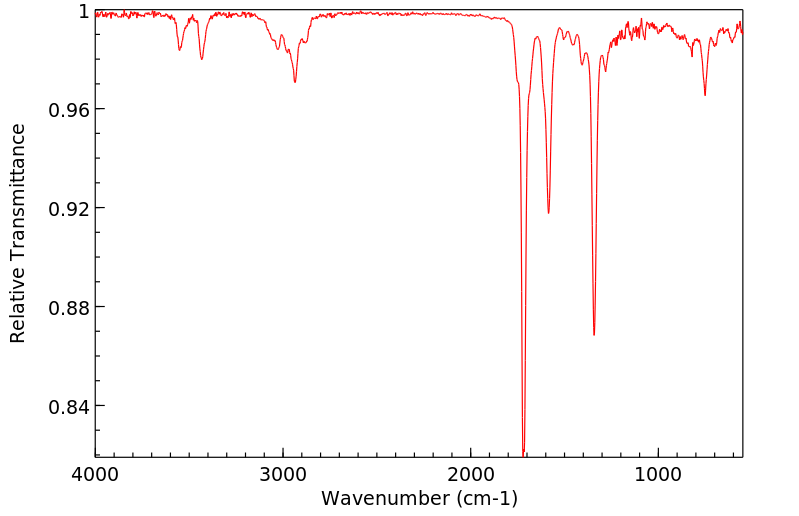3,4-二甲基苯甲酰胺 | 5580-33-6
中文名称
3,4-二甲基苯甲酰胺
中文别名
——
英文名称
3,4-dimethylbenzamide
英文别名
3,4-Dimethyl-benzamid
CAS
5580-33-6
化学式
C9H11NO
mdl
MFCD00052960
分子量
149.192
InChiKey
INGCXEIJXKQPJH-UHFFFAOYSA-N
BEILSTEIN
——
EINECS
——
-
物化性质
-
计算性质
-
ADMET
-
安全信息
-
SDS
-
制备方法与用途
-
上下游信息
-
文献信息
-
表征谱图
-
同类化合物
-
相关功能分类
-
相关结构分类
物化性质
-
熔点:101-103°C
-
沸点:251.3±29.0 °C(Predicted)
-
密度:1.060±0.06 g/cm3(Predicted)
-
稳定性/保质期:
在常温常压下保持稳定。
计算性质
-
辛醇/水分配系数(LogP):2.1
-
重原子数:11
-
可旋转键数:1
-
环数:1.0
-
sp3杂化的碳原子比例:0.222
-
拓扑面积:43.1
-
氢给体数:1
-
氢受体数:1
安全信息
-
安全说明:S26,S36/37/39
-
危险类别码:R36/37/38
-
海关编码:2924299090
-
储存条件:请将药品存放在避光、阴凉干燥处,并密封保存。
SDS
| Name: | 3 4-Dimethylbenzamide 97% Material Safety Data Sheet |
| Synonym: | |
| CAS: | 5580-33-6 |
Synonym:
Section 2 - COMPOSITION, INFORMATION ON INGREDIENTS
| CAS# | Chemical Name | content | EINECS# |
| 5580-33-6 | 3,4-Dimethylbenzamide | 97% | unlisted |
Risk Phrases: None Listed.
Section 3 - HAZARDS IDENTIFICATION
EMERGENCY OVERVIEW
Not available.
Potential Health Effects
Eye:
May cause eye irritation.
Skin:
May cause skin irritation. May be harmful if absorbed through the skin.
Ingestion:
May cause irritation of the digestive tract. May be harmful if swallowed.
Inhalation:
May cause respiratory tract irritation. May be harmful if inhaled.
Chronic:
Not available.
Section 4 - FIRST AID MEASURES
Eyes: Flush eyes with plenty of water for at least 15 minutes, occasionally lifting the upper and lower eyelids. Get medical aid.
Skin:
Get medical aid. Flush skin with plenty of water for at least 15 minutes while removing contaminated clothing and shoes.
Ingestion:
Get medical aid. Wash mouth out with water.
Inhalation:
Remove from exposure and move to fresh air immediately.
Notes to Physician:
Treat symptomatically and supportively.
Section 5 - FIRE FIGHTING MEASURES
General Information:
As in any fire, wear a self-contained breathing apparatus in pressure-demand, MSHA/NIOSH (approved or equivalent), and full protective gear.
Extinguishing Media:
Use water spray, dry chemical, carbon dioxide, or chemical foam.
Section 6 - ACCIDENTAL RELEASE MEASURES
General Information: Use proper personal protective equipment as indicated in Section 8.
Spills/Leaks:
Vacuum or sweep up material and place into a suitable disposal container.
Section 7 - HANDLING and STORAGE
Handling:
Avoid breathing dust, vapor, mist, or gas. Avoid contact with skin and eyes.
Storage:
Store in a cool, dry place. Store in a tightly closed container.
Section 8 - EXPOSURE CONTROLS, PERSONAL PROTECTION
Engineering Controls:
Use adequate ventilation to keep airborne concentrations low.
Exposure Limits CAS# 5580-33-6: Personal Protective Equipment Eyes: Not available.
Skin:
Wear appropriate protective gloves to prevent skin exposure.
Clothing:
Wear appropriate protective clothing to prevent skin exposure.
Respirators:
Follow the OSHA respirator regulations found in 29 CFR 1910.134 or European Standard EN 149. Use a NIOSH/MSHA or European Standard EN 149 approved respirator if exposure limits are exceeded or if irritation or other symptoms are experienced.
Section 9 - PHYSICAL AND CHEMICAL PROPERTIES
Physical State: Solid
Color: off-white
Odor: Not available.
pH: Not available.
Vapor Pressure: Not available.
Viscosity: Not available.
Boiling Point: Not available.
Freezing/Melting Point: 107 - 109 deg C
Autoignition Temperature: Not available.
Flash Point: Not available.
Explosion Limits, lower: Not available.
Explosion Limits, upper: Not available.
Decomposition Temperature:
Solubility in water:
Specific Gravity/Density:
Molecular Formula: C9H11NO
Molecular Weight: 149
Section 10 - STABILITY AND REACTIVITY
Chemical Stability:
Not available.
Conditions to Avoid:
Incompatible materials.
Incompatibilities with Other Materials:
Oxidizing agents, reducing agents, bases, acids.
Hazardous Decomposition Products:
Carbon monoxide, oxides of nitrogen, carbon dioxide.
Hazardous Polymerization: Has not been reported
Section 11 - TOXICOLOGICAL INFORMATION
RTECS#:
CAS# 5580-33-6 unlisted.
LD50/LC50:
Not available.
Carcinogenicity:
3,4-Dimethylbenzamide - Not listed by ACGIH, IARC, or NTP.
Section 12 - ECOLOGICAL INFORMATION
Section 13 - DISPOSAL CONSIDERATIONS
Dispose of in a manner consistent with federal, state, and local regulations.
Section 14 - TRANSPORT INFORMATION
IATA
No information available.
IMO
No information available.
RID/ADR
No information available.
Section 15 - REGULATORY INFORMATION
European/International Regulations
European Labeling in Accordance with EC Directives
Hazard Symbols: Not available.
Risk Phrases:
Safety Phrases:
S 24/25 Avoid contact with skin and eyes.
WGK (Water Danger/Protection)
CAS# 5580-33-6: No information available.
Canada
None of the chemicals in this product are listed on the DSL/NDSL list.
CAS# 5580-33-6 is not listed on Canada's Ingredient Disclosure List.
US FEDERAL
TSCA
CAS# 5580-33-6 is not listed on the TSCA inventory.
It is for research and development use only.
SECTION 16 - ADDITIONAL INFORMATION
N/A
上下游信息
-
上游原料
中文名称 英文名称 CAS号 化学式 分子量 3,4-二甲基苯甲醛 3,4-dimethylbenzaldehyde 5973-71-7 C9H10O 134.178 -
下游产品
中文名称 英文名称 CAS号 化学式 分子量 N,3,4-三甲基苯甲酰胺 N,3,4-trimethylbenzamide 3400-36-0 C10H13NO 163.219 —— N-benzyl-3,4-dimethylbenzamide 333348-33-7 C16H17NO 239.317 —— N,N′-(1,4-phenylenebis(methylene))bis(3,4-dimethylbenzamide) —— C26H28N2O2 400.521
反应信息
-
作为反应物:描述:3,4-二甲基苯甲酰胺 在 N-甲基苯甲酰胺 、 苯硅烷 、 C28H18ClMnN2O2 、 potassium tert-butylate 、 sodium hydroxide 作用下, 以 四氢呋喃 为溶剂, 反应 2.0h, 以89%的产率得到3,4-二甲基苯腈参考文献:名称:伯酰胺对胺或腈的作用:单一催化剂的双重作用†摘要:我们报道了锰催化的各种伯酰胺向胺的加氢甲硅烷基化还原(25个例子)。通过简单地改变反应条件,例如在催化量的仲酰胺存在下,相同的催化剂就能以优异的收率将伯酰胺转化为中间体腈化合物(16个实例)。这是第一个实例,其中已经证明了用单一催化剂将伯酰胺控制地催化转化为胺或腈。DOI:10.1039/c9cc05856g
-
作为产物:描述:参考文献:名称:Terakawa et al., Yakugaku Zasshi/Journal of the Pharmaceutical Society of Japan, 1954, vol. 74, p. 312,314摘要:DOI:
文献信息
-
Transition metal-free catalytic reduction of primary amides using an abnormal NHC based potassium complex: integrating nucleophilicity with Lewis acidic activation作者:Mrinal Bhunia、Sumeet Ranjan Sahoo、Arpan Das、Jasimuddin Ahmed、Sreejyothi P.、Swadhin K. MandalDOI:10.1039/c9sc05953a日期:——potassium complex was used as a transition metal-free catalyst for reduction of primary amides to corresponding primary amines under ambient conditions. Only 2 mol% loading of the catalyst exhibits a broad substrate scope including aromatic, aliphatic and heterocyclic primary amides with excellent functional group tolerance. This method was applicable for reduction of chiral amides and utilized for the synthesis
-
Acetamides and benzamides that are useful in treating sexual dysfunction申请人:——公开号:US20040029887A1公开(公告)日:2004-02-12The present invention relates to the use of compounds of formula (I) 1 for the treatment of sexual dysfunction and to compositions containing compounds of formula (I) for the treatment of sexual dysfunction.本发明涉及使用式(I)的化合物治疗性功能障碍,以及含有式(I)化合物的组合物用于治疗性功能障碍。
-
An NHC‐Stabilised Phosphinidene for Catalytic Formylation: A DFT‐Guided Approach作者:P. Sreejyothi、Kalishankar Bhattacharyya、Shiv Kumar、Pradip Kumar Hota、Ayan Datta、Swadhin K. MandalDOI:10.1002/chem.202101202日期:2021.8.11In recent years, the applications of low-valent main group compounds have gained momentum in the field of catalysis. Owing to the accessibility of two lone pairs of electrons, NHC-stabilised phosphinidenes have been found to be excellent Lewis bases; however, they cannot yet be used as catalysts. Herein, an NHC-stabilised phosphinidene, 1,3-dimethyl-2-(phenylphosphanylidene)-2,3-dihydro-1H imidazole近年来,低价主族化合物在催化领域的应用得到了蓬勃发展。由于两个孤对电子的可及性,已发现 NHC 稳定的膦亚基是极好的路易斯碱;然而,它们还不能用作催化剂。在此,报道了一种 NHC 稳定的膦亚基,1,3-二甲基-2-(苯基亚膦基)-2,3-二氢-1 H咪唑 (1),用于活化 CO 2。对 CO 2活化的仔细检查通过 DFT 计算以及本征键轨道分析的过程表明,膦亚基通过两个苯环之间的非共价 π-π 相互作用与苯基硅烷相关联,这激活了 Si-H 键,促进了氢化物转移到 CO 2分子。详细的 DFT 研究与光谱实验相结合,以了解 CO 2活化的机制及其催化还原官能化,导致一系列化学惰性伯酰胺在温和反应条件下甲酰化。
-
[EN] ARYLMETHYLENE HETEROCYCLIC COMPOUNDS AS KV1.3 POTASSIUM SHAKER CHANNEL BLOCKERS<br/>[FR] COMPOSÉS HÉTÉROCYCLIQUES D'ARYLMÉTHYLÈNE UTILISÉS EN TANT QUE BLOQUEURS DES CANAUX POTASSIQUES KV1.3 DE TYPE SHAKER申请人:DE SHAW RES LLC公开号:WO2021071806A1公开(公告)日:2021-04-15A compound of Formula (I) or a pharmaceutically acceptable salt thereof is described, wherein the substituents are as defined herein. Pharmaceutical compositions comprising the same and method of using the same are also described.描述了化合物的公式(I)或其药学上可接受的盐,其中取代基如本文所定义。还描述了包含相同化合物的药物组合物以及使用该药物的方法。
-
Nickel-Catalyzed Phosphine Free Direct N-Alkylation of Amides with Alcohols作者:Jagadish Das、Debasis BanerjeeDOI:10.1021/acs.joc.7b03215日期:2018.3.16Herein, we developed an operational simple, practical, and selective Ni-catalyzed synthesis of secondary amides. Application of renewable alcohols, earth-abundant and nonprecious nickel catalyst facilitates the transformations, releasing water as byproduct. The catalytic system is tolerant to a variety of functional groups including nitrile, allylic ether, and alkene and could be extended to the synthesis
表征谱图
-
氢谱1HNMR
-
质谱MS
-
碳谱13CNMR
-
红外IR
-
拉曼Raman
-
峰位数据
-
峰位匹配
-
表征信息
同类化合物
(βS)-β-氨基-4-(4-羟基苯氧基)-3,5-二碘苯甲丙醇
(S,S)-邻甲苯基-DIPAMP
(S)-(-)-7'-〔4(S)-(苄基)恶唑-2-基]-7-二(3,5-二-叔丁基苯基)膦基-2,2',3,3'-四氢-1,1-螺二氢茚
(S)-盐酸沙丁胺醇
(S)-3-(叔丁基)-4-(2,6-二甲氧基苯基)-2,3-二氢苯并[d][1,3]氧磷杂环戊二烯
(S)-2,2'-双[双(3,5-三氟甲基苯基)膦基]-4,4',6,6'-四甲氧基联苯
(S)-1-[3,5-双(三氟甲基)苯基]-3-[1-(二甲基氨基)-3-甲基丁烷-2-基]硫脲
(R)富马酸托特罗定
(R)-(-)-盐酸尼古地平
(R)-(-)-4,12-双(二苯基膦基)[2.2]对环芳烷(1,5环辛二烯)铑(I)四氟硼酸盐
(R)-(+)-7-双(3,5-二叔丁基苯基)膦基7''-[((6-甲基吡啶-2-基甲基)氨基]-2,2'',3,3''-四氢-1,1''-螺双茚满
(R)-(+)-7-双(3,5-二叔丁基苯基)膦基7''-[(4-叔丁基吡啶-2-基甲基)氨基]-2,2'',3,3''-四氢-1,1''-螺双茚满
(R)-(+)-7-双(3,5-二叔丁基苯基)膦基7''-[(3-甲基吡啶-2-基甲基)氨基]-2,2'',3,3''-四氢-1,1''-螺双茚满
(R)-(+)-4,7-双(3,5-二-叔丁基苯基)膦基-7“-[(吡啶-2-基甲基)氨基]-2,2”,3,3'-四氢1,1'-螺二茚满
(R)-3-(叔丁基)-4-(2,6-二苯氧基苯基)-2,3-二氢苯并[d][1,3]氧杂磷杂环戊烯
(R)-2-[((二苯基膦基)甲基]吡咯烷
(R)-1-[3,5-双(三氟甲基)苯基]-3-[1-(二甲基氨基)-3-甲基丁烷-2-基]硫脲
(N-(4-甲氧基苯基)-N-甲基-3-(1-哌啶基)丙-2-烯酰胺)
(5-溴-2-羟基苯基)-4-氯苯甲酮
(5-溴-2-氯苯基)(4-羟基苯基)甲酮
(5-氧代-3-苯基-2,5-二氢-1,2,3,4-oxatriazol-3-鎓)
(4S,5R)-4-甲基-5-苯基-1,2,3-氧代噻唑烷-2,2-二氧化物-3-羧酸叔丁酯
(4S,4''S)-2,2''-亚环戊基双[4,5-二氢-4-(苯甲基)恶唑]
(4-溴苯基)-[2-氟-4-[6-[甲基(丙-2-烯基)氨基]己氧基]苯基]甲酮
(4-丁氧基苯甲基)三苯基溴化磷
(3aR,8aR)-(-)-4,4,8,8-四(3,5-二甲基苯基)四氢-2,2-二甲基-6-苯基-1,3-二氧戊环[4,5-e]二恶唑磷
(3aR,6aS)-5-氧代六氢环戊基[c]吡咯-2(1H)-羧酸酯
(2Z)-3-[[(4-氯苯基)氨基]-2-氰基丙烯酸乙酯
(2S,3S,5S)-5-(叔丁氧基甲酰氨基)-2-(N-5-噻唑基-甲氧羰基)氨基-1,6-二苯基-3-羟基己烷
(2S,2''S,3S,3''S)-3,3''-二叔丁基-4,4''-双(2,6-二甲氧基苯基)-2,2'',3,3''-四氢-2,2''-联苯并[d][1,3]氧杂磷杂戊环
(2S)-(-)-2-{[[[[3,5-双(氟代甲基)苯基]氨基]硫代甲基]氨基}-N-(二苯基甲基)-N,3,3-三甲基丁酰胺
(2S)-2-[[[[[((1S,2S)-2-氨基环己基]氨基]硫代甲基]氨基]-N-(二苯甲基)-N,3,3-三甲基丁酰胺
(2S)-2-[[[[[[((1R,2R)-2-氨基环己基]氨基]硫代甲基]氨基]-N-(二苯甲基)-N,3,3-三甲基丁酰胺
(2-硝基苯基)磷酸三酰胺
(2,6-二氯苯基)乙酰氯
(2,3-二甲氧基-5-甲基苯基)硼酸
(1S,2S,3S,5S)-5-叠氮基-3-(苯基甲氧基)-2-[(苯基甲氧基)甲基]环戊醇
(1S,2S,3R,5R)-2-(苄氧基)甲基-6-氧杂双环[3.1.0]己-3-醇
(1-(4-氟苯基)环丙基)甲胺盐酸盐
(1-(3-溴苯基)环丁基)甲胺盐酸盐
(1-(2-氯苯基)环丁基)甲胺盐酸盐
(1-(2-氟苯基)环丙基)甲胺盐酸盐
(1-(2,6-二氟苯基)环丙基)甲胺盐酸盐
(-)-去甲基西布曲明
龙蒿油
龙胆酸钠
龙胆酸叔丁酯
龙胆酸
龙胆紫-d6
龙胆紫








